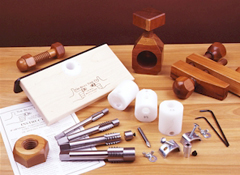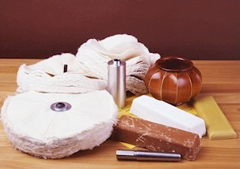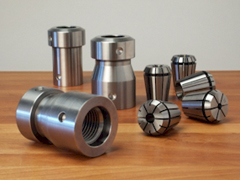
Jerrold Roger Beall, or J.R. to most who know him, is nothing if not eclectic. To know that at 71 he has been a professional woodworker for more than 35 years and an inventor for more than two decades does little to explain either his fascinating and checkered career, or his company’s catalog, which offers a variety of tools that are just perfect for those nasty jobs that no other tool does easily.
The Beall Tool Company is probably best known for two items, both of which sprang from J.R.’s fertile mind. The Wood Buff, with its various formats for the insides and outsides of bowls and turnings, is a favorite among the lathe crowd, but it is The Beall Wood Threader, a router-based tool for making threads on wood shafts, that started it all.
After a stint in the Navy, J.R. went to work for AT&T for a dozen years, then left to teach industrial arts in Utica, Ohio. He became a luthier in 1967, making dulcimers during the folk music craze.
“I started selling them at shows, and moved on to mouth bows, guitars, harpsichords, lutes, autoharps, hammer dulcimers, psalteries, virginals, clavichords, hurdy gurdy everything but violins.” Along the way, he started the Guild of American Luthiers, the oldest guitarmaking guild in America. “I put an ad in guitar player magazine asking if anyone wanted to start a guild, just for the hell of it. But I did not play music, so after about a decade, I got tired of just making them. I just like to build stuff.”
By 1982, he switched to making clocks, coming up with a weird design that incorporated wooden nuts and bolts. As a result of needing a lot of wooden bolts, he became disenchanted with what was then the standard thread box. Instead, he designed a better way of threading using a router attachment and a carbide bit, patented it, and called it “The Beall Wood Threader.”

“I had an injection mold made, took the first batch of threaders to a New York wood show, and sold 75 of them for about 75 dollars each. This seemed much better, and more profitable, than selling my woodwork. Before I knew it, I was in the tool business as well as the clock business.”
At shows, his eye-catching U-shaped wooden bolts always triggered the magic line: “How did you do that?” “I tell them I use two threaders sided by side,” he said with a chuckle, showing the fine sense of humor that is evident throughout his catalog, web site, and a book he wrote and published called “The Nuts and Bolts of Woodworking.”
Eventually, the clock business disappeared, and the wood buff was born. Sold both direct and through most woodworking specialty stores, “The Beall Wood Buff” is a system with three buffs on one mandrel. It currently outsells everything else in his catalog combined.
“In the process of doing arts and crafts shows, I noticed that the people who make briar pipes always buffed them with a wheel, and they looked great. I asked a couple of them if they had ever tried that on anything other than briar, and they said no. I bought one, and found it worked on everything.”

Although buffers were common to the trades, they were virtually unknown in the craft world. He introduced an industrial technique, in a cost effective way, to craftspeople.
His catalog is also peppered with other seemingly unconnected, but equally clever, items. The Beall Collet Chuck accepts ER32 collets, a standard metalworking collet available anywhere. It lets you feed stock through from the back of the headstock, will not mark the wood, and loading and unloading it is much faster than a three- or four-jaw chuck. The Hinge Wizard is a device for installing quadrant, Soss, and box hinges on jewelry boxes and humidors. He also sells hinges, including a round hinge he designed that can be inlet with a Forstner bit. The Lock Wizard, similarly, installs full mortise locks.
There is also a treen mandrel, called, you guessed it, The Beall Treen Mandrel, that simplifies the task of making small turned boxes. It grips from the inside, allowing you to turn thin walls, because the mandrel is steel. Add to that a quarter inch corner chisel, an inclinometer, digital readouts, a Vernier protractor, humidor gear, and more. There’s even a Woodworker’s Wall Chart, another J.R. design, chock-a-block with helpful must-have information.

Lest you were worried, allow me to assure you he still dabbles in something other than tools. He also makes very high-end kaleidoscopes for collectors that run up to $8,000 and clocks with wooden gears and mechanisms. He is currently working on a clock powered by bows instead of springs, so we can probably expect to see some clock making tools in the near future. Another new item on the horizon is a small, inexpensive, hand-pumped vacuum bag that requires no compressor. Clearly, this is one busy man.
“It’s been such a long and interesting career,” Beall told me. “I could write a book about it if I only had the time.”





